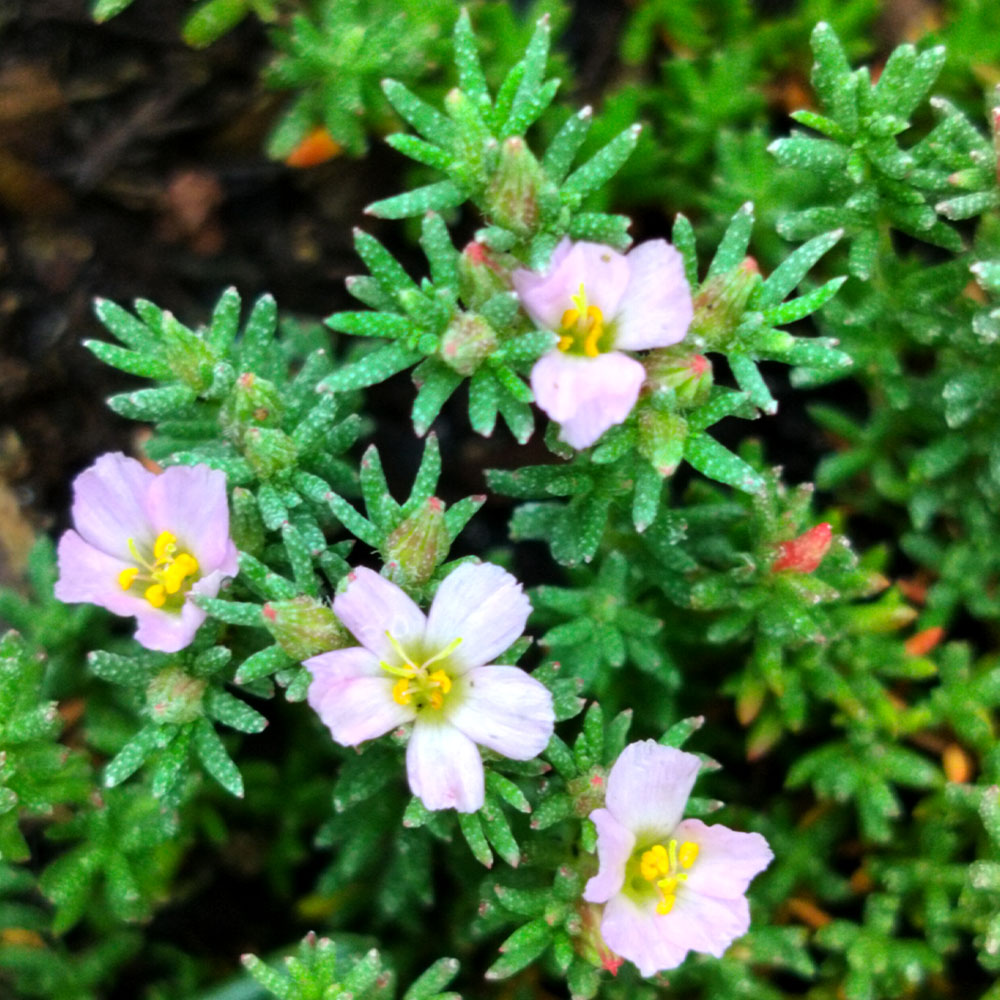No products in the cart.
Frankenia laevis
A coastal groundcover known for its lavender flowers
Rated 0 out of 5
0 customer reviews
4,90 € – 12,00 €Price range: 4,90 € through 12,00 €
Tags: chaud, couleur, couvre sol, evergreen, feuillage persistant, perennial, secheresse, soleil, vivace, vivace en pot, xeriscaping
SKU: pda382
Category: Balcony-Friendly, Bees and Butterflies, Evergreen, Frost Hardy, Ground Cover, Make it Pop, Rewild

Frankenia laevis
4,90 € – 12,00 €Price range: 4,90 € through 12,00 €
Frankenia laevis is a low-growing, mat-forming evergreen perennial that spreads gracefully to create a dense, lush carpet of foliage.
In spring, it bursts into a profusion of delicate, soft-colored flowers, adding both texture and subtle beauty to rocky gardens, coastal landscapes, and sunny, well-drained areas.
Its compact growth habit and evergreen nature make it an excellent choice for ground cover, providing year-round greenery while attracting pollinators with its charming seasonal blooms
The leaves are small, linear to lanceolate leaves, grey-green and sometimes slightly sticky; they will often turning reddish-copperish in the winter.
The flowers are tiny but abundant pink to pale lilac blooms with yellow centers, appearing from late spring through summer
The growth habit is slow but dense – overtime it will create a soft cushion-like ground cover.
👩🌾GARDENING TIPS 👩🌾:
-
-
Great for green roofs, gravel gardens, and coastal borders
-
Attracts small pollinators
-
Excellent ground cover for hot, dry, and even salty conditions
-
Also suitable for cracks in paving or walls due to its tough, spreading habit
- Looks great with:
-
Thymus spp. (Thyme) – Aromatic mats that bloom slightly later than Frankenia, adding fragrance and attracting pollinators.
-
Erinus alpinus – Compact, tufted clumps with purple flower spheres, perfect for rocky soils.
-
Sedum spp. (Stonecrop) – Succulent rosettes that tolerate poor soils and summer drought.
-
Lavandula angustifolia (Lavender) – Taller, grey evergreen shrubs that provide contrast in texture and scent.
-
- Looks great with:
-
Learn more about gardening with Frankenia laevis:
The Tales & The Botany: Frankenia laevis
The genus Frankenia was named in honor of the German botanist Johann Franck, with Frankenia laevis being one of the evergreen coastal species in the Frankenaceae family. These low-growing, mat-forming perennials are native to Europe, North Africa, and parts of western Asia, thriving in sunny, rocky, and saline environments, including coastal cliffs and limestone outcrops.
Frankenia laevis is valued for its drought and salt tolerance, forming dense mats that stabilize soil and prevent erosion. Its stems are woody at the base, with semi-succulent tips that allow survival in harsh, dry conditions. The leaves are small, narrow, and leathery, with a slightly glaucous coating that reflects sunlight and minimizes water loss.
🌸 Floral Morphology
Flowers of Frankenia laevis are solitary or in small terminal clusters, producing delicate pink to lilac blooms from late spring through summer.
They are actinomorphic (this means that it is characterized by radial symmetry) pentamerous (this means that it has five petals), and relatively small (around 5–10 mm in diameter).
Each flower contains a persistent calyx and numerous prominent stamens, which contrast attractively with the soft-colored petals.
The leaves are opposite, simple, entire, and slightly succulent, helping the plant retain water in dry or saline soils.
🌱 Reproductive Biology
Flowers are hermaphroditic, enabling both self-pollination and cross-pollination.
Pollination is predominantly entomophilous, with bees, butterflies, and other insects visiting for pollen.
Fruits are small dehiscent capsules containing numerous tiny seeds, which germinate best in well-drained soils exposed to sun, allowing Frankenia laevis to colonize rocky crevices and coastal ledges.
🌍 Ecology & Adaptations
Frankenia laevis is emblematic of Mediterranean and coastal alpine ecosystems, particularly on sandy, rocky, or saline soils. Key adaptations include:
-
-
High drought tolerance, via semi-succulent leaves and a mat-forming growth habit.
-
Salt tolerance, allowing growth near sea spray or coastal soils.
-
Low nutrient requirements, thriving on poor, well-drained limestone soils.
-
Soil stabilization, forming dense mats that reduce erosion on slopes and cliffs.
-
These traits make Frankenia laevis a resilient, low-maintenance plant that is ideal for rock gardens, coastal terraces, and sunny xeriscapes, while also providing nectar for pollinators and visually attractive, long-lasting ground cover.
Other Names:
Sea Heath
Smooth Frankenia
Origin:
Western Europe, the Mediterranean basin, and North Africa
| Weight | 0,5 kg |
|---|---|
| Flowering | July, August, September |
| Soil | Sandy, Rocky/Well-Draining |
| Exposure | Full Sun |
| Frost Tolerance | -5°C to -10°C |
| Size | 0.10m H x as far as you let it go |
| Other Powers | Salt Tolerant |
| Container Size | 9×9 cm, 2L |
Reviews
0
Rated 0 out of 5
0 customer reviews
5
0
4
0
3
0
2
0
1
0
Only logged in customers who have purchased this product may leave a review.
You may also like…
Delosperma nubigenum
A resilient ground cover with bright yellow flowers
A resilient ground cover with bright yellow flowers
Rated 0 out of 5
Cerastium tomentosum var. columnae
A grey-green spreading ground cover from the mountains.
A grey-green spreading ground cover from the mountains.
Rated 0 out of 5
Delosperma cooperi
A dwarf perennial known for its vermillion colored flowers
A dwarf perennial known for its vermillion colored flowers
Rated 0 out of 5
Related Products
Aptenia cordifolia Variegata
A succulent plant in the iceplant family with bright carmine flowers.
A succulent plant in the iceplant family with bright carmine flowers.
Rated 0 out of 5
Euphorbia myrsinites
Known for its draping form of silver-gray foliage and radiant blooms.
Known for its draping form of silver-gray foliage and radiant blooms.
Rated 0 out of 5
Hellebore argutifolius
Winter flowering perennial with marbled blue-green leaves
Winter flowering perennial with marbled blue-green leaves
Rated 0 out of 5
Glechoma hederacea
A sweet smelling ground cover, producing little blue flowers all summer long.
A sweet smelling ground cover, producing little blue flowers all summer long.
Rated 0 out of 5
Erigeron kavinskianus
A daisy-like carpet of flowers
A daisy-like carpet of flowers
Rated 0 out of 5
Tanacetum densum subsp amani
A shrublet composed of soft, finely divided silvery gray-white leaves.
A shrublet composed of soft, finely divided silvery gray-white leaves.
Rated 0 out of 5
Kalanchoe daigremontiana
A toothy succulent from Madagascar, known as the Mother of Thousands.
A toothy succulent from Madagascar, known as the Mother of Thousands.
Rated 0 out of 5
Hieracium maculatum Leopard
A native perennial with blue-green leaves and a tall yellow flower
A native perennial with blue-green leaves and a tall yellow flower
Rated 0 out of 5
Stachys byzantina
Silky white-grey leaves and tall striking flowers
Silky white-grey leaves and tall striking flowers
Rated 0 out of 5
Euphorbia cyparissias Clarice Howard
A Euphorbia that resembles a soft little cyprus tree
A Euphorbia that resembles a soft little cyprus tree
Rated 0 out of 5
Trachelospermum asiaticum ‘Ogon Nishiki’
Jasmine with colorful foliage and lovely white flowers in summer
Jasmine with colorful foliage and lovely white flowers in summer
Rated 0 out of 5
Melissa officinalis
A perennial plant in the mint family that is adored by bees, royal families and tea drinkers.
A perennial plant in the mint family that is adored by bees, royal families and tea drinkers.
Rated 0 out of 5
Sedum album
A low, multi-color ground cover.
A low, multi-color ground cover.
Rated 0 out of 5
Tradescantia Blushing Bride
Gorgeous blushes of pink and white that appear in the coldest nights.
Gorgeous blushes of pink and white that appear in the coldest nights.
Rated 0 out of 5
Vinca minor
Looping elegance and ability to form a low flowering ground cover
Looping elegance and ability to form a low flowering ground cover
Rated 0 out of 5
Mentha x piperita ‘Chartreuse’
A spicy mint, known for its use in the production of liqueurs and herbal teas.
A spicy mint, known for its use in the production of liqueurs and herbal teas.
Rated 0 out of 5
Echinacea purpurea
A perennial with purple flowers all summer long
A perennial with purple flowers all summer long
Rated 0 out of 5
Artemisia Valerie Finnis
A semi-evergreen, aromatic variation on the theme of Artemisia.
A semi-evergreen, aromatic variation on the theme of Artemisia.
Rated 0 out of 5
recent view product
Origanum vulgare Variegatum
A dense carpet of green and cream fragrant leaves
A dense carpet of green and cream fragrant leaves
Rated 0 out of 5
Cistus salvifolius
Mediterranean bush with sage-like leaves and ivory white flowers
Mediterranean bush with sage-like leaves and ivory white flowers
Rated 0 out of 5
Chrysanthemum Julie Lagravère
A perennial that produces many burgundy red flowers
A perennial that produces many burgundy red flowers
Rated 0 out of 5
Liriope muscari ‘Big Blue’
A perennial with evergreen grass-like leaves and tall spikes of lilac flowers in the fall
A perennial with evergreen grass-like leaves and tall spikes of lilac flowers in the fall
Rated 0 out of 5
Geum hybrid coccineum “Carlskaer”
Loved for its neon yellow petals and orange-yellow stamens
Loved for its neon yellow petals and orange-yellow stamens
Rated 0 out of 5



















































There are no reviews yet.